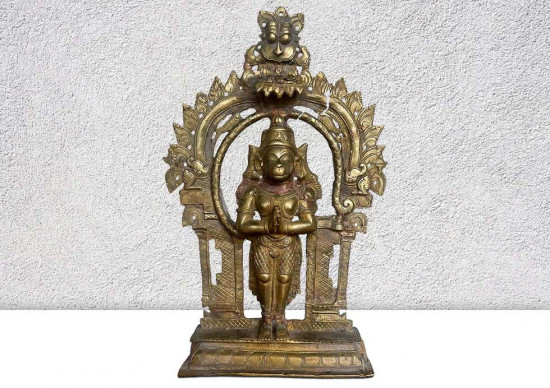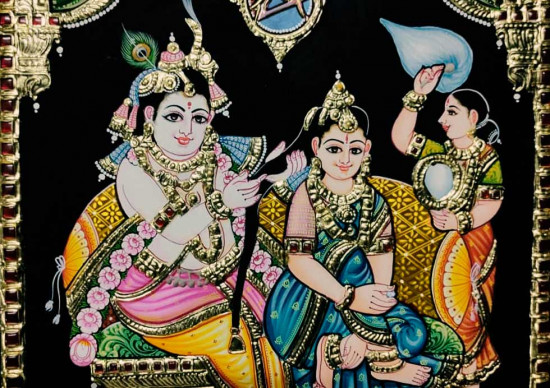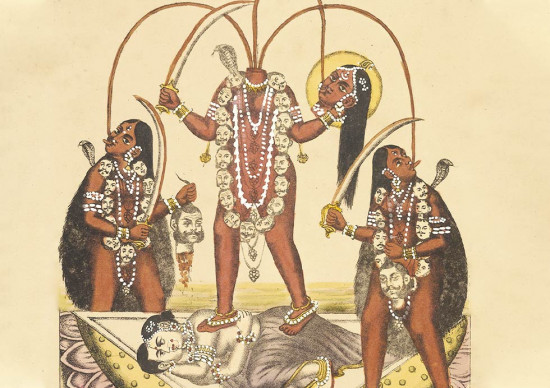
The Story of Navratri

Mahishasura became very proud and started to cause trouble for everyone. He captured Svarga Loka (heaven), the home of the gods, and made them very scared. The gods were worried and asked the Trimurti, the trinity of hindu Gods, Brahma, Vishnu and Mahesh (Shiva). Together, they created a powerful goddess with their powers named Adi Shakti, who was a warrior with many arms. She rode a lion which Himavan gave her.
Adi Shakti is another name of Goddess Durga, who then went to fight Mahishasura. The demon tried to trick her by changing into different forms, but Goddess Durga was too strong and smart. She defeated him every time. Finally, she killed him with her trident when he turned into a buffalo.
Devi Durga is a very important goddess in Hinduism and also called Mahisasurmardini. She is worshiped for her courage, strength, and her ability to protect people from evil. She is often pictured riding a lion and holding a trident.

The Significance of Durga Puja
Here are the nine Devi forms worshiped during Navratri:

- Shailaputri: The first night of Navratri is dedicated to Shailaputri, the daughter of the mountain. She is often depicted riding a bull and carrying a lotus flower. Shailaputri represents purity, innocence, and the beginning of creation.
- Brahmacharini: The second night is dedicated to Brahmacharini, the one who is dedicated to spiritual practices. Goddess Durga as Brahmcharini is often depicted as a young girl carrying a kamandalu (water pot) and a rosary. Brahmacharini symbolizes knowledge, discipline, and the path to enlightenment.
- Chandi: The third night is dedicated to Chandi, the fierce warrior goddess. She is often depicted riding a tiger or lion and carrying a trident. Chandi represents courage, power, and the ability to overcome obstacles.
- Kushmanda: The fourth night is dedicated to Kushmanda, the creator of the universe. She is often depicted riding a lion and carrying a lotus flower with eight petals. Kushmanda represents abundance, prosperity, and the power of creation.
- Skandamata: The fifth night is dedicated to Skandamata, the mother of Skanda (also known as Murugan or Kartikeya), the god of war. She is often depicted riding a lion and carrying a child. Skandamata represents motherhood, compassion, and the ability to nurture and protect.
- Katyayani: The sixth night is dedicated to Katyayani, the goddess of war. She is often depicted riding a lion and carrying a sword and a lotus flower. Katyayani represents strength, determination, and the ability to conquer enemies.
- Mahagauri: The seventh night is dedicated to Mahagauri, the great goddess. She is often depicted riding a bull and carrying a damru (a small drum). Mahagauri represents wisdom, enlightenment, and the power of creation.
- Siddhidatri: The eighth night is dedicated to Siddhidatri, the goddess of accomplishment. She is often depicted riding a lion and carrying a lotus flower and a mace. Siddhidatri represents success, achievement, and the ability to overcome challenges.
- Mahakali: The ninth night is dedicated to Mahakali, the ultimate form of the Divine Feminine. She is often depicted riding a buffalo and carrying a sword and a skull. Mahakali represents destruction, transformation, and the power of the universe.
Traditions and Rituals

Durga Puja is celebrated with great pomp and fervor across India, but it is particularly grand in the eastern states of West Bengal, Bihar, Jharkhand, and Odisha. The festival is marked by a series of rituals and traditions, including:
- Pandal Hopping: One of the most popular activities during Durga Puja is "pandal hopping," where people visit the elaborately decorated pandals (temporary structures) set up in neighborhoods and public spaces. These pandals showcase intricate artwork, sculptures, and lighting displays, depicting the story of Durga's victory over Mahishasura.
- Puja Rituals: The core of Durga Puja is the worship of the goddess. Devotees offer flowers, fruits, sweets, and other offerings to the goddess, seeking her blessings for prosperity, health, and happiness. The puja is typically performed by a priest, who recites mantras and hymns.
- Immersion Ceremony: On the tenth day of Navratri, known as Vijayadashami, the idols of the goddess are immersed in a river or other body of water. This symbolizes the goddess's return to her heavenly abode. The immersion ceremony is a joyous occasion, marked by singing, dancing, and celebrations.









